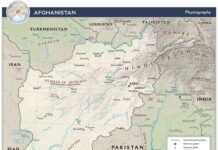Context
 It is becoming clear that the military strategy in Pakistan involves a three-pronged centripetal approach: one team is conducting operations in Dir in the southwest, the second one in Buner to the east, while the third, the Special Services Group (SGG) Commandos, are blocking the fall- back area for the Taliban towards the north, in Peochar Valley. There is a growing belief that a major confrontation, in the form of urban warfare, will take place in Mingora City.
It is becoming clear that the military strategy in Pakistan involves a three-pronged centripetal approach: one team is conducting operations in Dir in the southwest, the second one in Buner to the east, while the third, the Special Services Group (SGG) Commandos, are blocking the fall- back area for the Taliban towards the north, in Peochar Valley. There is a growing belief that a major confrontation, in the form of urban warfare, will take place in Mingora City.
The Pakistani government has blamed foreign elements, particularly India, for providing support to these militant elements and extremists. Uzbek and Tajik militants are also believed to be involved. A look at the geography and history of the region offers the key to dealing with the situation: preventing extremists from escaping through the mountains and stopping the flow of foreign support to them.
Analysis
The ongoing operation in Swat involves the Pakistani Army’s best-trained counterinsurgency soldiers and the stakes are high. The Army’s effectiveness in dealing with such growing threats to the country’s integrity and sovereignty will be tested by the speed with which they defeat Taliban militants. Moreover, the operation provides unique opportunities for the Army. It will have the chance to demonstrate to the satisfaction of the west and the world that it is determined to fight the extremists. It will also have the opportunity to further refine the lessons learned from the operation conducted in Bajuar Agency, which many observers consider to be a success, despite the high number of IDPs.
Obviously, it is important to consider how the Taliban insurgents will react. Will they stand their ground or, as they have usually done in the past, make a run for the hills, only to fight another day? Ultimately, the upper hand will be achieved, not by controlling the ground, but, as history would suggest, through dominating the major mountain passes of the area, thus blocking the Taliban escape and support routes. Only then can negotiations, hopefully resulting in some kind of permanent settlement, be considered viable.
The major mountain passes with in Pakistan include:
- The Lowari Pass
- The Malakand Pass
- The Karakar Pass
- The Ambela Pass
- The Buner Pass
- The Shangla Pass

There are three other major passes connecting to Chitral.
- The Shandur Top provides access from Chitral to Gilgit, Pakistan.
- The Dorah Pass connects Badakshan in Afghanistan with Chitral. It is said that during the Soviet invasion of Afghanistan, the Soviets were unable to stop the flow of arms and men back and forth across the pass; as a result, the entire Munji-speaking population of Afghanistan fled across the border to Chitral.
- The Baroghil (3,798 Meters) and Kachin (5,693 Meters) Passes provide entry to Chitral from the Wakhan Corridor in Afghanistan. Baroghil has seldom been used as an invasion route. During the 19th century, the British greatly feared that the Russians would use the pass to invade the heartland of British India. These fears, however, proved groundless, probably because of the difficult terrain. Historians speculate that Marco Polo may have crossed the Baroghil Pass and Pamirs to reach China.

|
Because these northern passes are shorter than the southern ones, they are very useful to the militants and extremists in Swat. So in the present context, it is possible that pressure in the Swat Valley will push the Taliban further north, into Chitral. The Taliban have never been able to gain a foothold here, as this area is occupied by different ethnic groups. Along this trajectory, Gilgit and Kashmir could very well be next in line.
|
Prominent Passes of Swat
The Karakar Pass (el. 1336 m./4384 ft.) From the top of the pass, one can view the Buner Valley. It was at this pass that the Emperor Akbar lost most of his 8,000-man army in an abortive attempt to invade Swat in 1586. The Malakand Pass The easiest approach to Swat is through the Malakand Pass; the Morah and Shakot passes to the east are both more difficult. From the viewpoint of about one kilometer before the top of the pass, one can see the Swat Canal in the valley below. It was built by the British to channel water from the Swat River through a tunnel under the Malakand Pass to the plains around Mardan. On the other side of the pass, the road descends through the market town of Bat Khela with a Hindu Shahi fort perched above it and then continues past the head works of the Swat Canal to the Swat River. The first bridge across the river is at Chakdara, which carries the road to Dir and Chitral.
The famous Ambella Pass, situated in Buner, can easily be approached from Mardan, via Shahbaz Garhi and Rustam. It is about 50 kms away from Mardan. In 1863 the British fought a very tough battle here against Yusufzai Afghan Lashkars. The Muslim graveyard of martyrs, the Baba Ji Kandao, where Hazrat Saidu Baba camped, the Craig Picker and the Eagles Nest can all still be seen here. The Shangla Pass Despite the lack of evidence, people like to tell and retell the story of Alexander the Great visiting the ShanglaPass, the shortest route between the Swat valley and the Valley of the Indus. In the east, the Pass is bounded by the Battagram District and the Kala Dhaka mountain of Hazara. On the west, Shangla is neighbored by the Swat District while in the south lies the Buner and Kala Dhaka districts. The District of Kohistan lies to its north. |
Tell Us What You Think
Feedback@politact.com




